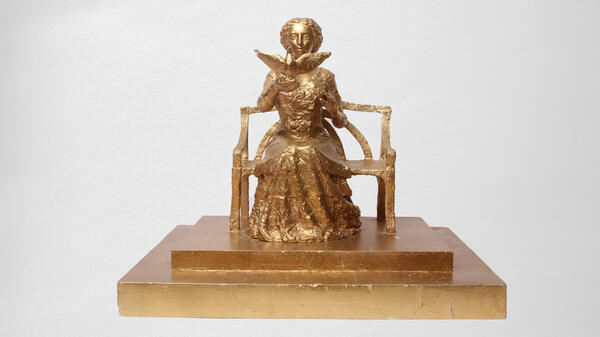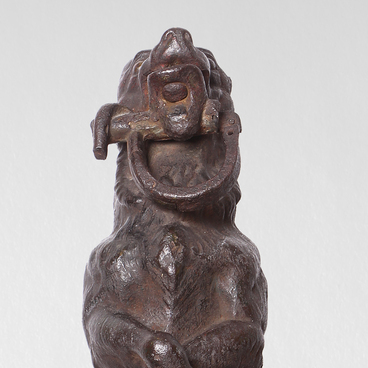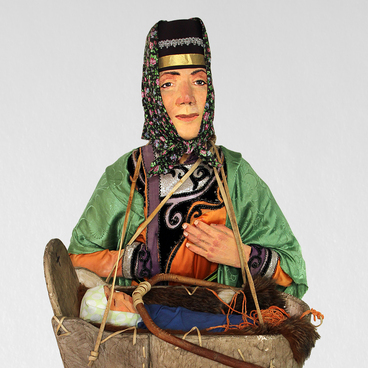Tomsk sculptor Leontiy Usov gave the museum an exact model of his sculpture of Empress Maria. The master made the copy from metal wire and plaster and painted it gold. It is located on a pedestal 50 by 50 centimeters.
Monument to the Empress Maria Alexandrovna was casted in bronze and erected in Mariinsk at public expense in September 2007. According to the author’s idea, the sculpture of Maria is performed in the park style. The Empress is seated on a bench, and she releases a dove from her hands, a symbol of peace and the seven gifts of the Holy Spirit. These images denote the blessing the town received from the Empress.
By 1856, the population of the village of Kiisky (now Mariinsk) was 3.500 people. It became the largest settlement in Western Siberia. The village had about 450 households and dozens of market stalls. That is why it was decided to give Kiisk status of a town. The Governor-General of Western Siberia Gustav Gasfort appealed to the Siberian Committee with a request to rename the new town Aleksandrovsk after the reigning emperor.
The committee approved the initiative and gave the governor an album with photographs of Kiisky and a petition to give the city a new name. Alexander II did not agree with the proposed name. On the journal of the Siberian Committee he wrote “Mariinsk”. Thus, on August 4 (July 22, O.S.), 1857, on the Empress’ saint’s day, the city was renamed after Maria Alexandrovna.
Maria Romanova, born Princess Maximiliana Wilhelmina Augusta Sophia Maria of Hesse and Rheinland, came from the Duchy of Hesse-Darmstadt and was a member of the Lutheran Church. Married to Alexander II, she converted to Orthodoxy and chose a Russian name.
The Empress contributed to the history of the Russian state as a philanthropist, patroness of arts, founder of the Red Cross and founder of the all-women’s gymnasiums. According to recollections of contemporaries, Maria Alexandrovna was ‘a woman of meek character, very pious and reserved.’ In the last years of her life the empress’s health declined and she died in St. Petersburg from tuberculosis.
Monument to the Empress Maria Alexandrovna was casted in bronze and erected in Mariinsk at public expense in September 2007. According to the author’s idea, the sculpture of Maria is performed in the park style. The Empress is seated on a bench, and she releases a dove from her hands, a symbol of peace and the seven gifts of the Holy Spirit. These images denote the blessing the town received from the Empress.
By 1856, the population of the village of Kiisky (now Mariinsk) was 3.500 people. It became the largest settlement in Western Siberia. The village had about 450 households and dozens of market stalls. That is why it was decided to give Kiisk status of a town. The Governor-General of Western Siberia Gustav Gasfort appealed to the Siberian Committee with a request to rename the new town Aleksandrovsk after the reigning emperor.
The committee approved the initiative and gave the governor an album with photographs of Kiisky and a petition to give the city a new name. Alexander II did not agree with the proposed name. On the journal of the Siberian Committee he wrote “Mariinsk”. Thus, on August 4 (July 22, O.S.), 1857, on the Empress’ saint’s day, the city was renamed after Maria Alexandrovna.
Maria Romanova, born Princess Maximiliana Wilhelmina Augusta Sophia Maria of Hesse and Rheinland, came from the Duchy of Hesse-Darmstadt and was a member of the Lutheran Church. Married to Alexander II, she converted to Orthodoxy and chose a Russian name.
The Empress contributed to the history of the Russian state as a philanthropist, patroness of arts, founder of the Red Cross and founder of the all-women’s gymnasiums. According to recollections of contemporaries, Maria Alexandrovna was ‘a woman of meek character, very pious and reserved.’ In the last years of her life the empress’s health declined and she died in St. Petersburg from tuberculosis.



